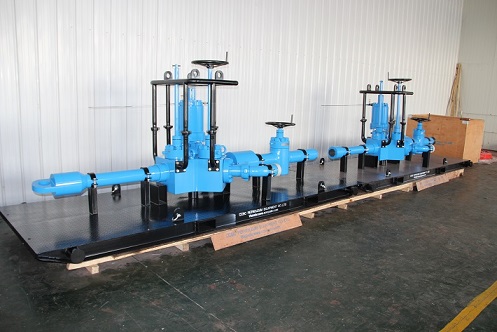Surface Test Tree - Flowhead
Flowhead - surface test tree consists of four gate valves: a master valve, two wing valves, and a swab valve. The outlet wing valve is opened and closed using an hydraulic actuator. Above the swab valve is a lifting subassembly (sub) with a threaded connection. The threaded connection is often called a quick union. The quick union is used to connect auxiliary pressure equipment which is needed if tools are to be run downhole. Some flowheads have a protection frame bolted to the main block to prevent damage to the valves during handling. Beneath the optional swivel are the master valve assembly and the bottom sub. In order to raise and lower a drill stem test (DST) string, elevators (clamps) are attached to the flowhead.

Basic to the operation of the flowhead is the opening and closing of valves in a particular sequence or order depending on what operation needs to be done. The following list describes several common operations and provides figures that show the typical status of the valves for these operations. The valve settings may change depending on whether other operations must be performed simultaneously.
The handling sub also provides an interface to the surface wireline or coiled tubing equipment. A dynamic swivel is located between the main valve block and the lower master valve, allowing rotation of the string without rotating the flowhead, and preventing any rig movement from transferring torque into the riser or landing string.
Swivel
The flowhead swivel is inserted between the master valve and the main valve block. It allows the subsurface equipment to be rotated with respect to the main flowhead block. Using a swivel, it is possible to rotate the subsurface equipment without disconnecting the flow line or the kill line. An example of this is using the swivel to set the drill stem test (DST) packer downhole. Another example is to re-latch the subsurface connection used with floating rigs.
The swivel is designed to allow rotation of the subsurface string while supporting the weight of the whole subsurface string. Roller bearings are used to support the significant weight of the test string and the downhole tools. Ball bearings are used to support the lighter weight of the flowhead and the equipment above the flowhead.
The swivel should not be rotated under pressure which means that it is not designed to hold the pressure when submitted to a continuous rotating movement like in drilling operations. The most common applications (as mentioned earlier) are done with the pressure close or equal to zero at a very low rotating speed . During a well test, the pressure can be close to the swivel working pressure but the swivel either does not move (onshore) or oscillates a little due to the heave (offshore).
http://www.joboilfield.com/







